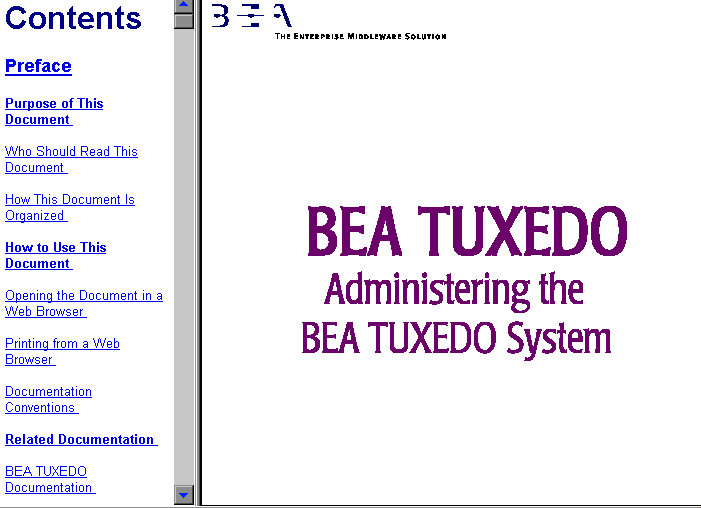
[Top]
[Previous Page] [Next Page] [Bottom]
This document describes how to administer the BEA TUXEDO system.
This document is intended for administrators who configure operational parameters that support mission-critical BEA TUXEDO systems.
Administering the BEA TUXEDO System is organized as follows:
UBBCONFIG configuration file.
Chapter 4 explains how to start and shut down
applications.
Chapter 5 explains how to distribute
applications.
Chapter 6 explains how to build networked
applications.
Chapter 7 explains how to configure transactions.
Chapter 8 explains how to manage multiple domains.
Chapter 9 explains how to manage workstation
clients.
Chapter 10 explains how to manage queued messages.
Chapter 11 explains how to implement application
security.
Chapter 12 explains how to monitor a running
system.
Chapter 13 explains how to monitor log files.
Chapter 14 explains how to tune applications.
Chapter 15 explains how to migrate applications.
Chapter 16 explains how to modify systems
dynamically.
Chapter 17 explains how to reconfigure
applications dynamically.
Chapter 18 explains how to use the Event Broker.
Chapter 19 explains how to troubleshoot problems.
This document, Administering the BEA TUXEDO System, is designed primarily as an online, hypertext document. If you are reading this as a paper publication, note that to get full use from this document you should access it as an online document via the BEA TUXEDO Online Documentation CD.
The following sections explain how to view this document online, and how to print a copy of this document.
To access the online version of this document, open the index.htm file in the top-level
directory of the BEA TUXEDO Online Documentation CD. On the main menu, click the Bookshelf
button. On the Bookshelf, scroll to the entry for Administering the BEA TUXEDO System and
click the HTML option. The CD provides other options to open this document. The preceding
example describes one option.
Note: The online documentation requires a Web browser that supports HTML version 3.0. Netscape Navigator version 3.0 or Microsoft Internet Explorer version 3.0 or later is recommended.
Figure 1 shows the online document with the clickable navigation bar and table of contents.Figure 1 Online Document Displayed in a Netscape Web Browser

You can print a copy of this document, one file at a time, from the Web browser. Before you print, make sure that the chapter or appendix you want is displayed and selected in your browser.
To select a chapter or appendix, click anywhere inside the chapter or appendix you want to print. If your browser offers a Print Preview feature, you can use the feature to verify which chapter or appendix you are about to print. If your browser offers a Print Frames feature, you can use the feature to select the frame containing the chapter or appendix you want to print. For example:

The BEA TUXEDO Online Documentation CD also includes Adobe Acrobat PDF files of all of the online documents. You can use the Adobe Acrobat Reader to print all or a portion of each document. On the CD's main menu, click the Bookshelf button. On the Bookshelf, scroll to the entry for the BEA TUXEDO document you want to print and click the PDF option.
The following documentation conventions are used throughout this document.
The following sections list the documentation provided with the BEA TUXEDO software, related BEA publications, and other publications related to the technology.
The BEA TUXEDO information set consists of the following documents:
BEA TUXEDO Release Notes
Administering the BEA TUXEDO System (this document)
Application Developer' s Guide
COBOL Guide
Domains User Guide
FML Programmer's Guide
Glossary
Installation Guide
Product Overview
Programmer's Guide
/Q Guide
TxRPC Guide
Windows NT User's Guide
/Workstation Guide
Note: The BEA TUXEDO Online Documentation CD also includes Adobe Acrobat PDF files of all of the online documents. You can use the Adobe Acrobat Reader to print all or a portion of each document.
Selected BEA TUXEDO Release 6.4 documents are available on the Online Documentation CD.
To access these documents:
For more information about the BEA TUXEDO system and related technologies, refer to the following books:
Edwards, J. with DeVoe, D. 1997. 3-Tier Client/Server At Work. Wiley Computer Publishing.
Edwards, J., Harkey, D., and Orfali, R. 1996. The Essential Client/Server Survival Guide. Wiley Computer Publishing.
The following sections provide information about how to obtain support for the documentation and software.
If you have questions or comments on the documentation, you can contact the BEA Information Engineering Group by e-mail at docsupport@beasys.com.
If you have any questions about this version of the BEA TUXEDO system, or if you have
problems installing and running the BEA TUXEDO system, contact BEA Customer Support
through BEA WebSupport at www.beasys.com.
You can also contact Customer Support by using the contact information provided on the
Customer Support Card, which is included in the product package.
When contacting Customer Support, be prepared to provide the following information:
[Top] [Previous Page] [Next Page] [Bottom]